The St Ignatius Bridge in Region 9 gave way under the weight of a truck which was transporting an excavator on Wednesday evening and residents say the mishap could have been avoided if warnings were heeded.
Region 9 Chairman Wilson Lorentino, who travelled to the capital city to engage the Local Government Ministry on the issue, told Stabroek News yesterday that he was informed by the Chairman of the Interim Management Committee (IMC) of the Lethem Neighbourhood Democratic Council (NDC) that the bridge was unstable.
A driver attached to the IMC had reportedly crossed the bridge before 18:00 hrs on Wednesday and noticed that it was “shaking”, Lorentino said. The observation was conveyed to the IMC Chairman who suggested to him that a sign be placed at the bridge to warn unwary crossers.
However, heavy rainfall prevented regional officials from taking immediate action. Instead, a decision was taken to erect the notice yesterday morning.
By this time it was too late.
He said that yesterday morning the Regional Office received calls alerting them to what had transpired.
Minister of Local Government Ganga Persaud could not be contacted for a comment on the issue owing to obligations which took him to Region 8.
Contact was established with Minister within the Local Government Ministry Norman Whittaker and Permanent Secretary Collin Croal, but neither could say much, since they too were in Region 8 and had not been properly briefed on what had transpired.

Several regional officials yesterday said that though there were no reported injuries resulting from the accident, it highlighted the need for better enforcement of weight limit restrictions as it relates to the use of bridges.
Carl Parker, a Region 9 Councillor yesterday said that “the non-enforcement of weight limits on the bridges in the area has long been an issue,” and could very well be one of the factors which led to the unfortunate event.
Parker said the remote nature of these bridges has led to a situation where it is virtually impossible for the regional administrators to enforce weigh limit restrictions. He said that since 1998 he has been advocating for the construction of concrete bridges, which, though substantially more expensive to build, would be far sturdier than the current wooden structures. He said he had suggested that one concrete bridge be built per year and opined that all of the bridges in the area could have already been converted to concrete structures if his suggestion was heeded.
A resident of the area, Mr Beckles, further suggested that poor construction could have led to the accident. Beckles, who owns an establishment which deals in the distribution of construction equipment, told Stabroek News yesterday that the wrong sized rods were used in the bridge’s construction and this may have led to the breaking of one of the concrete beams which supported the structure.
In addition, he said, the foundation of the concrete beams, which had been embedded in the bed of the Moco-Moco Creek, was insufficient. Beckles said recent rainy weather in the area had led to the severe swelling of the creek which eroded not only its banks, but its bed as well. As such, he said, the structure’s foundation had been exposed, compromising its soundness.
Douglas Casimero, Vice Chairman of Region 9’s Regional Democratic Council (RDC) yesterday explained that he was told about the accident around 10:00 hrs yesterday. He added that he and other regional officials made initial checks around 10:30 hrs and determined that no one had been injured.
Detailing what had transpired, Casimero told Stabroek News that the St Ignatius Bridge, which connects St Ignatius to Lethem, was broken by a truck transporting an excavator. The vehicle was making its way to Lethem.
Casimero said the bridge was usually capable of handling heavy traffic. In fact, Stabroek News understands that the St Ignatius Bridge is recommended by regional officials for use by heavy machinery.
Beckles said the other bridge in the area, located about 300 metres away from the Lethem airstrip, was open only to pedestrians and light vehicular traffic. He added that permanent barriers installed on that bridge prevent heavy-duty vehicles from crossing it. The man said that regional officials should have taken more care in the bridge’s construction and maintenance, especially since it was the only bridge in the area that heavy vehicles could use.
Meanwhile, Casimero said the bridge was very sturdy having been constructed of solid wooden components which were supported by concrete beams. He however admitted that from all indications the bridge clearly gave way under the combined weight of the truck and the excavator.
Casimero said such heavy-duty traffic would usually go to and from their destinations via the “Moco-Moco river bed”. He said though that the current rainy season had swelled the body of water making the creek impassable.
The vehicles, he said, have therefore been forced to utilise the bridge.
Stabroek News understands that the current state of the bridge will directly affect two sub districts; South Central and the Deep South Rupununi.
Both Lorentino and Casimero were unable to immediately say who would bear responsibility for reconstructive works to the bridge.
Minister of Transport and Hydraulics Robeson Benn could not be contacted for a comment.
According to reports, it is common for heavy-duty machinery to traverse the road heading to the south Rupununi, damaging roads and bridges as they go along.
Parker yesterday said that the increased instances of damage are indicative of the fact that the region lacks the necessary infrastructure to support the development which is occurring.
He said infrastructural developmental programmes—to build more sturdy roads, bridges and other structures—are imperative if the current economic growth being experienced in the region is be properly accommodated.





